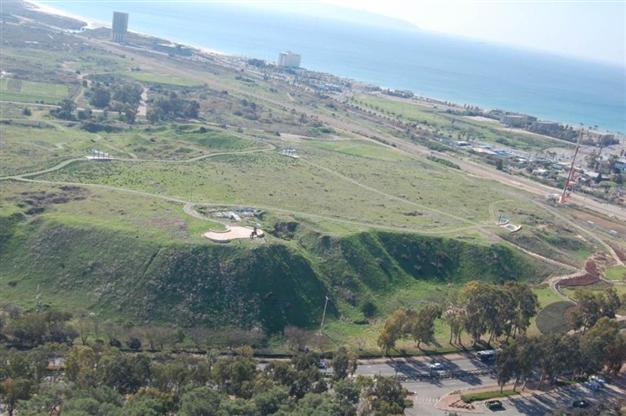Re-evaluating conflict through archaeology, amid uncertain peace
Delphine Rodrik - TEL AKKO
 At around 5:30 a.m. on Tel Akko, the temperature is already climbing steadily. But in early July of 2014, the region’s most recent conflict has not yet reached its boiling point. Further south, children have already become casualties of the latest violence between Israel’s military and Gaza’s militants. Schools have been ordered shut and summer camps put on hold, rockets have launched, Israel’s active reserve forces are growing.
At around 5:30 a.m. on Tel Akko, the temperature is already climbing steadily. But in early July of 2014, the region’s most recent conflict has not yet reached its boiling point. Further south, children have already become casualties of the latest violence between Israel’s military and Gaza’s militants. Schools have been ordered shut and summer camps put on hold, rockets have launched, Israel’s active reserve forces are growing.It could be any point in Akko’s turbulent history, but this Monday it is quiet and still, one of the calmer places on the coast of the Levant. As the rising sun dissolves clouds over the Galilee’s east, the Mediterranean grows in blue below the crusader walls of Akko’s Old City, its minarets and towers sharpened in resolution. To the south of the Tel, known by locals as Napoleon Hill, a metal silhouette of the prospective invader on a reared horse watches over the city, alerting the unaware to its significance even today.
Up here with this view, it’s easy to understand why Akko was the object of conquest for centuries, millennia—and perhaps even now, located on Israeli land that many claim as Palestine. Today those living in Akko’s Old City are predominantly Arab, while those in the surrounding New City make up the majority of its Jewish community, about 75 percent of Akko’s total population. In a couple hours, a group of 12 Arab and Jewish high school students from Akko will join Penn State’s archaeological excavation on the Tel.
In archaeological terms, all this might be considered part of a modern stratigraphy, the layers of an archaeological site that reveal different periods of occupation and use. An excavation is in its own way a conflict, one you must tackle by layer, as you might approach any mess or disorder. Archaeologists are in search of an increasingly comprehensive, and complex, picture—yet one that is rarely ever perfectly complete—of the relationships between different features, periods, and those who lived among them.
I’m in Akko this day for the start of programming with the Society for Humanitarian Archaeological Research and Exploration (SHARE), an American non-profit that utilizes archaeology and conservation to bring together youth in regions of ethnic and territorial conflict. Interaction and understanding is the prerequisite for any sustainable solution between young Israelis and Palestinians, SHARE maintains, and the team-oriented nature of archaeology provides a uniquely neutral setting to facilitate communication.
In Israel-Palestine in particular, archaeology is highly politicized, often a means of claiming ownership to the past and present, both unclear. But although the summer’s escalating violence has the potential to set Arab and Jews in harsh contrast, SHARE’s students form friendships that display the opposite. In the field, during workshops on pottery analysis and aerial photography, and throughout restoration projects at Akko’s International Conservation Center, students’ conversation and enthusiasm are more common than the collision of rocket fire only a few miles south. Their interaction often displays the unconditional joy—echoing cheering and laughter over dares during lunch, for instance—that knows no boundaries, barriers, separation walls.
Perhaps the ease with which SHARE’s students open up to each other is natural for a generation that shares more across a regularly promoted false dichotomy—Israelis vs. Palestinians—seeking to divide them. Together, they know fear: of sharing the wrong opinion with the wrong person; of speaking the wrong language in the wrong place; of being in the wrong place at the wrong time; of periodic, inevitable, seemingly eternal war.
Together, they also share ambition, a critical idealism. SHARE’s students aspire to be politicians, musicians, artists; they want to “change the unfair world,” in the words of one. They are big dreamers, uncertain of whether circumstances will keep these goals forever dreams.
In Akko, I’m constantly reminded of the immediacy and insistence with which both the recent and ancient past clings to daily life. While one of our Muslim students is fasting for Ramadan, two other Jewish students are fasting for the Seventeenth of Tammuz, in remembrance of the Roman attack on the walls of Jerusalem. Even celebration and commemoration here overlap, history repeated and retold.
That leaves archaeology inescapable, as well. While helping a family dig holes to support a fence in their front yard, for instance, we find long-broken pottery a few inches down, alongside dirt and stones. It’s from the Ottoman period, you can tell: modern remains. Don’t forget the history that unfolds at your feet, this onetime-jug seems to say, or isolate what it holds. I am not all ancient.
Archaeology, we explain to our students on that early July day, is a necessarily destructive practice: To understand a site, walls and floors must be uncovered, recorded, and then removed. The students’ creativity allows them to grasp the concept intrinsically; they imagine, connect, reconstruct. We understand, they insist. They are anxious to get digging.
Seeing with a simple wisdom inherent in youth, they might find a sense of order from chaos, peace from conflict, the foundations of a new era directly above ruins of the last. Happiness, these young adults know, is a culture, friendship a faith, and compromise a politics understood by all. And always, they remind us, these things must be shared.
















